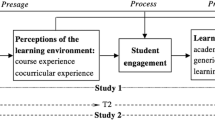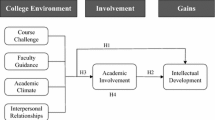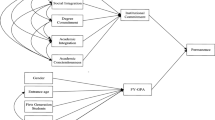Abstract
The transition to higher education and the initial phase of studying play a crucial role in future educational decisions and academic development. To successfully manage this transition, a certain degree of integration into the new environment is required. For this reason, and drawing on the conceptual framework of Tinto’s model of student departure, the study examines academic integration as an important first-year experience. Going beyond Tinto’s approach and most of the previous research, both individual and contextual factors were analysed by estimating multilevel structural equation models. Data were taken from a panel study of new entrants to higher education institutions in Germany (N = 10,697), which is part of the National Educational Panel Study (NEPS). The results corroborate previous findings and confirm the importance of psychological attributes like self-esteem and conscientiousness. They also provide evidence that a cognitively activating learning environment enhances academic integration considerably. However, direct instruction was found to negatively affect academic integration. The study concludes with a discussion of limitations and implications for practice and future research.

Similar content being viewed by others
References
Bahr, P. R., Toth, C., Thirolf, K., & Massé, J. C. (2013). A review and critique of the literature on community college students’ transition processes and outcomes in four-year institutions. In M. B. Paulsen (Ed.), Higher education: Handbook of theory and research (Vol. 28, pp. 459–511). Dordrecht: Springer.
Beaten, M., Dochy, F., & Struyven, K. (2013). The effects of different learning environments on students’ motivation for learning and their achievement. Br J Educ Psychol, 83(3), 484–501.
Bleidorn, W., Arslan, R. C., Denissen, J. J. A., Rentfrow, P. J., Gebauer, J. E., Potter, J., & Gosling, S. D. (2016). Age and gender differences in self-esteem – a cross-cultural window. J Pers Soc Psychol, 111(3), 396–410.
Blossfeld, H.-P., Roßbach, H.-G., & von Maurice, J. (Eds.). (2011). Education as a lifelong process – The German National Educational Panel Study (NEPS). Zeitschrift für Erziehungswissenschaft, Special Issue 14.
Bowman, N. A., & Denson, N. (2014). A missing piece of the departure puzzle: student-institution fit and intent to persist. Res High Educ, 55(2), 123–142.
Brandtstädter, J., & Renner, G. (1990). Tenacious goal pursuit and flexible goal adjustment: explication and age-related analysis of assimilative and accommodative strategies of co**. Psychol Aging, 5(1), 58–67.
Braxton, J. M., & Hirschy, A. S. (2005). Theoretical developments in the study of college student departure. In A. Seidman (Ed.), College student retention. Formula for student success (pp. 61–87). Westport: Praeger Publishers.
Braxton, J. M., & Lien, L. A. (2000). The viability of academic integration as a central construct in Tinto’s interactionalist theory of college student departure. In J. M. Braxton (Ed.), Reworking the student departure puzzle (pp. 11–28). Nashville: Vanderbilt University Press.
Braxton, J. M., Milem, J. F., & Sullivan, A. S. (2000). The influence of active learning on the college student departure process: toward a revision of Tinto’s theory. J High Educ, 71(5), 569–590.
Briggs, A. R. J., Clark, J., & Hall, I. (2012). Building bridges: understanding student transition to university. Qual High Educ, 18(1), 3–21.
Bronfenbrenner, U. (1979). The ecology of human development: Experiments by nature and design. Cambridge: Harvard University Press.
Busato, V. V., Prins, F. J., Elshout, J. J., & Hamaker, C. (2000). Intellectual ability, learning style, personality, achievement motivation and academic success of psychology students in higher education. Pers Individ Differ, 29(6), 1057–1068.
Coertjens, L., Brahm, T., Trautwein, C., & Lindblom-Ylänne, S. (2017). Students’ transition into higher education from an international perspective. High Educ, 73(3), 357–369.
DeBerard, M. S., Spielmans, G. I., & Julka, D. C. (2004). Predictors of academic achievement and retention among college freshmen: a longitudinal study. Coll Stud J, 38(1), 66–80.
Dickhäuser, O. (2006). Fähigkeitsselbstkonzept: Entstehung, Auswirkung, Förderung. Zeitschrift für Pädagogische Psychologie, 20(1/2), 5–8.
Fenollar, P., Roman, S., & Cuestas, P. J. (2007). University students’ academic performance: an integrative conceptual framework and empirical analysis. Br J Educ Psychol, 77(4), 873–891.
Gale, T., & Parker, S. (2012). Navigating change: a typology of student transition in higher education. Stud High Educ, 39(5), 734–753.
Georg, W. (2009). Individual and institutional factors in the tendency to drop out of higher education: a multilevel analysis using data from the Konstanz Student Survey. Stud High Educ, 34(6), 647–661.
Grässmann, R., Schultheiss, O. C., & Brunstein, J. C. (1998). Exploring the determinants of students’ academic commitment. In P. Nenniger, R. S. Jäger, A. Frey, & M. Wosnitza (Eds.), Advances in motivation (pp. 103–109). Landau: Verlag Empirische Pädagogik.
Heublein, U. (2014). Student drop-out from German higher education institutions. Eur J Educ, 49(4), 497–513.
Heublein, U., Ebert, J., Hutzsch, C., Isleib, S., König, R., Richter, J., & Woisch, A. (2017). Zwischen Studienerwartungen und Studienwirklichkeit. In Hannover: DZHW.
Hmelo-Silver, C. E., Duncan, R. G., & Chinn, C. A. (2007). Scaffolding and achievement in problem-based and inquiry learning: a response to Kirschner, Sweller, and Clark (2006). Educ Psychol, 42(2), 99–107.
Hsieh, P., Sullivan, J. R., & Guerra, N. S. (2007). A closer look at college students: self-efficacy and goal orientation. J Adv Acad, 18(3), 454–476.
Jenert, T., Postareff, L., Brahm, T., & Lindblom-Ylänne, S. (2015). Editorial: Enculturation and development of beginning students. Zeitschrift für Hochschulentwicklung, 10(4), 9–21.
Jenert, T., Brahm, T., Gommers, L., & Kühner, P. (2017). How do they find their place? A typology of students’ enculturation during the first year at a business school. Learn Cult Soc Interact, 12, 87–99.
Kappe, R., & van der Flier, H. (2012). Predicting academic success in higher education: what’s more important than being smart? Eur J Psychol Educ, 27(4), 605–619.
Kirschner, P. A., Sweller, J., & Clark, R. E. (2006). Why minimal guidance during instruction does not work: an analysis of the failure of constructivist, discovery, problem-based, experiential, and inquiry-based teaching. Educ Psychol, 41(2), 75–86.
Kreckel, R. (1994). Soziale Integration und nationale Identität. Berliner Journal für Soziologie, 4(1), 13–20.
Kuh, G. D., Cruce, T. M., Shoup, R., Kinzie, J., & Gonyea, R. M. (2008). Unmasking the effects of student engagement on first-year college grades and persistence. J High Educ, 79(5), 540–563.
Kyndt, E., Donche, V., Trigwell, K., & Lindblom-Ylänne, S. (2017). Understanding higher education transitions: Why theory, research and practice matter. In E. Kyndt, V. Donche, K. Trigwell, & S. Lindblom-Ylänne (Eds.), Higher education transitions. Theory and research (pp. 306–319). London: Routledge.
LeBreton, J. M., & Senter, J. L. (2008). Answers to 20 questions about interrater reliability and interrater agreement. Organ Res Methods, 11(4), 815–852.
Leese, M. (2010). Bridging the gap: supporting student transitions into higher education. J Furth High Educ, 34(2), 239–251.
Lüdtke, O., Trautwein, U., Kunter, M., & Baumert, J. (2007). Reliability and agreement of student ratings of the classroom environment: a reanalysis of TIMSS data. Learn Environ Res, 9(3), 215–230.
Lüdtke, O., Robitzsch, A., Trautwein, U., & Kunter, M. (2009). Assessing the impact of learning environments: how to use student ratings of classroom or school characteristics in multilevel modeling. Contemp Educ Psychol, 34(2), 120–131.
Lüdtke, O., Roberts, B. W., Trautwein, U., & Nagy, G. (2011). A random walk down university avenue: life paths, life events, and personality trait change at the transition to university life. J Pers Soc Psychol, 101(3), 620–637.
Mandl, H., & Kopp, B. (2005). Situated learning: Theories and models. In P. Nentwig & D. Weddington (Eds.), Making it relevant. Context based learning of science (pp. 15–34). Münster: Waxmann.
Marsh, H. W., Trautwein, U., Lüdtke, O., Köller, O., & Baumert, J. (2005). Academic self-concept, interest, grades, and standardized test scores: reciprocal effects models of causal ordering. Child Dev, 76(2), 397–416.
Marsh, H. W., Lüdtke, O., Robitzsch, A., Trautwein, U., Asparouhov, T., Muthén, B., & Nagengast, B. (2009). Doubly-latent models of school contextual effects: integrating multilevel and structural equation approaches to control measurement and sampling error. Multivar Behav Res, 44, 764–802.
Marsh, H. W., Lüdtke, O., Nagengast, B., Trautwein, U., Morin, A. J. S., Abduljabbar, A. S., & Köller, O. (2012). Classroom climate and contextual effects: conceptual and methodological issues in the evaluation of group-level effects. Educ Psychol, 47(2), 106–124.
Meng, C., & Heijke, H. (2005). Student time allocation, the learning environment and the acquisition of competencies. (Research Centre for Education and the Labour Market, Research Memorandum 2005/1E). Maastricht: Maastricht University.
Modood, T. (2015). Integration and multiculturalism: Focus on Western Europe. In J. D. Wright (Ed.), International encyclopedia of the social & behavioral sciences (2nd ed., pp. 235–242). Amsterdam: Elsevier.
Möller, J., & Trautwein, U. (2015). Selbstkonzept. In E. Wild & J. Möller (Eds.), Pädagogische Psychologie (2nd ed., pp. 177–199). Berlin, Heidelberg: Springer.
Muthén, L. K., & Muthén, B. O. (2015). Mplus user’s guide (Seventh ed.). Los Angeles: Muthén & Muthén.
Noyens, D., Donche, V., Coertjens, L., & van Petegem, P. (2017). Transitions to higher education: Moving beyond quantity. In E. Kyndt, V. Donche, K. Trigwell, & S. Lindblom-Ylänne (Eds.), Higher education transitions. Theory and research (pp. 3–12). London: Routledge.
OECD. (2015). Immigrant students at school: Easing the journey towards integration. Paris: OECD Publishing.
OECD. (2016). PISA 2015 results, volume I: Excellence and equity in education. Paris: OECD Publishing.
Pascarella, E. T., & Terenzini, P. T. (2005). How college affects students. A third decade of research. San Francisco: Jossey-Bass.
Pike, G. R., Kuh, G. D., & Gonyea, R. M. (2003). The relationship between institutional mission and students’ involvement and educational outcomes. Res High Educ, 44(2), 241–261.
Rammstedt, B., & John, O. P. (2007). Measuring personality in one minute or less: a 10-item short version of the Big Five Inventory in English and German. J Res Pers, 41, 203–212.
Richardson, M., Abraham, C., & Bond, R. (2012). Psychological correlates of university students’ academic performance: A systematic review and meta-analysis. Psychol Bull, 138(2), 353–387.
Robbins, S. B., Lauver, K., Le, H., Davis, D., Langley, R., & Carlstrom, A. (2004). Do psychosocial and study skill factors predict college outcomes? A meta-analysis. Psychol Bull, 130(2), 261–288.
Rosenshine, B. (1987). Direct instruction. In M. J. Dunkin (Ed.), The international encyclopedia of teaching and teacher education (pp. 257–262). Oxford: Pergamon Press.
Sawyer, R., Rutter, A., LeFevre, D., & Jason, M. (2015). Instruction. In S. J. Farenga & D. Ness (Eds.), Encyclopedia of education and human development (pp. 51–78). New York: Routledge.
Schaeper, H., & Weiß, T. (2016). The conceptualization, development, and validation of an instrument for measuring the formal learning environment in higher education. In H.-P. Blossfeld, J. von Maurice, M. Bayer, & J. Skopek (Eds.), Methodological issues of longitudinal surveys: The example of the National Educational Panel Study (pp. 269–292). Wiesbaden: Springer VS.
Schmidt, H. G., von Gog, T., & Paas, F. (2007). Problem-based learning is compatible with human cognitive architecture: commentary on Kirschner, Sweller, and Clark (2006). Educ Psychol, 42(2), 91–97.
Schneider, M., & Preckel, F. (2017). Variables associated with achievement in higher education: a systematic review of meta-analyses. Psychol Bull, 143(6), 565–600.
Severiens, S. E., & Schmidt, H. G. (2009). Academic and social integration and study progress in problem based learning. High Educ, 58(1), 59–69.
Specht, J., Luhmann, M., & Geiser, C. (2014). On the consistency of personality types across adulthood: latent profile analyses in two large-scale panel studies. J Pers Soc Psychol, 107(3), 540–556.
Tinto, V. (1975). Dropout from higher education. A theoretical synthesis of recent research. Rev Educ Res, 45(1), 89–125.
Tinto, V. (1993). Leaving college: Rethinking the causes and cures of student attrition (2nd ed.). Chicago: The University of Chicago Press.
Tinto, V. (1997). Classrooms as communities: exploring the educational character of student persistence. J High Educ, 68(6), 599–632.
Trapmann, S., Hell, B., Hirn, J.-O. W., & Schuler, H. (2007). Meta-analysis of the relationship between the Big Five and academic success at university. Zeitschrift für Psychologie, 215(2), 132–151.
Trautwein, C., & Bosse, E. (2017). The first year in higher education—critical requirements from the student perspective. High Educ, 73(3), 371–387.
Trautwein, U., Jonkmann, K., Gresch, C., Lüdtke, O., Neumann, M., Klusmann, U.,. . . Baumert, J. (2007). Transformation des Sekundarschulsystems und akademische Karrieren (TOSCA). Dokumentation der eingesetzten Items und Skalen, Welle 3. Berlin: Max-Planck-Institut für Bildungsforschung.
Vianello, M., Schnabel, K., Sriram, N., & Nosek, B. A. (2013). Gender differences in implicit and explicit personality traits. Pers Individ Differ, 55(8), 994–999.
von Collani, G., & Herzberg, P. Y. (2003). Eine revidierte Fassung der deutschsprachigen Skala zum Selbstwertgefühl von Rosenberg. Zeitschrift für Differentielle und Diagnostische Psychologie, 24(1), 3–7.
Vossensteyn, H., Kottmann, A., Jongbloed, B., Kaiser, F., Cremonini, L., Stensaker, B., & Wollscheid, S. (2015). Dropout and completion in higher education in Europe: Main report. Luxembourg: Publications Office of the European Union.
Wagner, J., Lüdtke, O., Jonkmann, K., & Trautwein, U. (2013). Cherish yourself: longitudinal patterns and conditions of self-esteem change in the transition to young adulthood. J Pers Soc Psychol, 104(1), 148–163.
Warm, T. A. (1989). Weighted likelihood estimation of ability in item response theory. Psychometrika, 54(3), 427–450.
Wohlkinger, F., Ditton, H., von Maurice, J., Haugwitz, M., & Blossfeld, H.-P. (2011). Motivational concepts and personality aspects across the life course. Zeitschrift für Erziehungswissenschaft, Special Issue, 14, 155–168.
Wohlkinger, F., Bayer, M., & Ditton, H. (2016). Measuring self-concept in the NEPS. In H.-P. Blossfeld, J. von Maurice, M. Bayer, & J. Skopek (Eds.), Methodological issues of longitudinal surveys: The example of the National Educational Panel Study (pp. 181–193). Wiesbaden: Springer VS.
Wolf-Wendel, L., Ward, K., & Kinzie, J. (2009). A tangled web of terms: the overlap and unique contribution of involvement, engagement, and integration to understanding college student success. J Coll Stud Dev, 40(4), 407–428.
Acknowledgements
This paper uses data from the National Educational Panel Study (NEPS; Starting Cohort First-Year Students; doi:https://doi.org/10.5157/NEPS:SC5:8.0.0). From 2008 to 2013, NEPS data was collected as part of the Framework Programme for the Promotion of Empirical Educational Research funded by the German Federal Ministry of Education and Research (Bundesministerium für Bildung und Forschung; BMBF). As of 2014, NEPS is carried out by the Leibniz Institute for Educational Trajectories (LIfBi) at the University of Bamberg in cooperation with a nationwide network.
Author information
Authors and Affiliations
Corresponding author
Additional information
Publisher’s note
Springer Nature remains neutral with regard to jurisdictional claims in published maps and institutional affiliations.
Electronic supplementary material
ESM 1
(PDF 121 kb)
Rights and permissions
About this article
Cite this article
Schaeper, H. The first year in higher education: the role of individual factors and the learning environment for academic integration. High Educ 79, 95–110 (2020). https://doi.org/10.1007/s10734-019-00398-0
Published:
Issue Date:
DOI: https://doi.org/10.1007/s10734-019-00398-0




